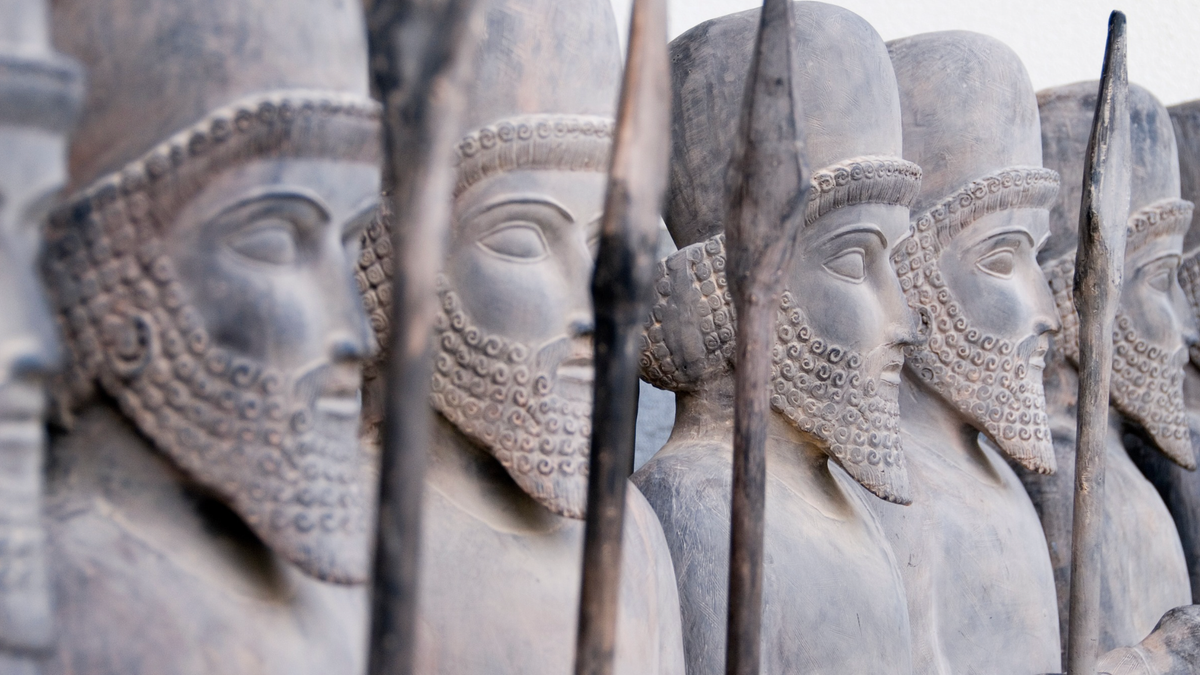Akkadian Empire: National Capability Assessment in its Bronze Age Context
Akkad forged the world’s first true empire, uniting Mesopotamia under a centralised monarchy that blended military power, administrative sophistication, and expansive trade networks into a model of Bronze Age imperial dominance.

Hard capabilities. The Akkadian Empire excelled in military organisation, territorial governance, and cultural integration at an unprecedented scale for Mesopotamia. It built on Sumerian technological foundations while developing imperial infrastructure and administrative systems that became templates for later empires.
Soft capabilities. Akkad’s elite culture blended Sumerian and Akkadian traditions, projecting a unifying imperial identity through language, religion, and monumental art. Education and record-keeping were expanded and standardised, but political cohesion proved fragile under environmental and external pressures.
Economic capabilities. Akkad’s command over irrigated agriculture, tribute networks, and long-distance trade routes extended its economic reach far beyond Sumerian precedents. However, its fiscal and logistical systems were vulnerable to climate shocks and the strains of overextension.
The Akkadian Empire’s capability profile reflects the transformation of Mesopotamia from a network of independent city-states into the world’s first territorial empire. Its hard capabilities fused technological refinement with administrative standardisation, allowing Akkad to govern diverse populations and distant provinces under a centralised authority. Strategic infrastructure—ranging from fortified urban hubs to road and courier networks—enabled imperial control over a territory far larger than any predecessor, while its military innovations, professionalised forces, and sustained campaigning extended Akkadian influence from the Persian Gulf to Anatolia. These advances marked a decisive evolution in the scale and scope of Bronze Age statecraft, positioning Akkad as the pre-eminent power of its era.
Supporting this was a set of soft and economic capabilities that ensured the empire could function cohesively across vast distances. A bilingual, professionally trained scribal class maintained records and correspondence, while monumental art, inscriptions, and architectural projects reinforced the ideology of divine kingship and broadcast imperial authority. The economy combined irrigated agriculture in its core with tribute, taxation, and control of long-distance trade routes linking the Indus Valley to the Levant. Large-scale workshops, efficient logistics, and a broad commercial network underpinned both military power and urban prosperity, even as dependence on these far-flung systems left the empire vulnerable to environmental stress and supply disruptions. Together, these strengths made Akkad a template for later empires—powerful, far-reaching, but ultimately challenged by the strains of overextension.
Hard Capabilities
Hard Capabilities in the Akkadian Empire reflected a decisive shift from the city-state model of Sumer to a centralised, territorially expansive power capable of projecting authority across much of the Near East. Building on Sumerian technological achievements, Akkad refined and standardised critical tools—from writing systems to military hardware—for use across a multi-ethnic empire. Its infrastructure evolved into a coordinated imperial network, linking distant provinces through roads, fortified cities, and administrative hubs. Coupled with a professionalised and far-reaching military, these capabilities enabled Akkad to sustain long campaigns, secure trade routes, and exert influence over a vast geographic area, marking it as one of the most strategically capable states of the Bronze Age.
Critical Technology
The Akkadian Empire inherited and adapted Sumerian breakthroughs—cuneiform writing, the wheel, advanced metallurgy, and sexagesimal mathematics—while standardising them for imperial administration. Akkadian scribes adapted Sumerian script for the Semitic Akkadian language, improving administrative consistency across diverse regions. These refinements, combined with continued innovation in siegecraft, bronze weaponry, and long-range communication, ensured Akkad remained technologically competitive with Egypt and advanced beyond its Mesopotamian predecessors in the integration of technology into imperial governance.
Strategic Infrastructure
Akkad maintained and expanded Sumer’s canal systems, fortified key cities, and developed a network of roads and couriers to connect distant provinces. Palaces, ziggurats, and administrative centres were constructed in the Akkadian style, reinforcing imperial presence. While still relying on mudbrick, the scale and geographic spread of these works marked a shift from city-state infrastructure to an imperial network capable of supporting long-distance control and trade.
National Security
Under Sargon and Naram-Sin, Akkad developed one of the most formidable military systems of the Bronze Age. Campaigns extended into Elam, the Levant, Anatolia, and Magan, with permanent garrisons and vassal states securing strategic corridors. The military combined professional core troops with conscripts, fielded chariotry and siege equipment, and projected force far beyond Mesopotamia. This capability placed Akkad ahead of its contemporaries in sustained territorial warfare.
Soft Capabilities
Soft Capabilities in the Akkadian Empire combined a highly trained administrative elite, a powerful cultural narrative, and a centralised governance system capable of managing a vast and diverse realm. Bilingual literacy in Sumerian and Akkadian enabled efficient record-keeping and diplomacy, while state-sponsored artisans and religious officials reinforced the empire’s prestige. Through art, inscriptions, and monumental architecture, Akkad projected an image of divine kingship that unified its provinces and extended its cultural reach well beyond its borders. This sophisticated integration of human capital, ideological influence, and administrative control allowed the empire to function cohesively at scale—though its centralised model also left it exposed to the strains of overextension and internal dissent.
Human Capital
Akkad expanded the Sumerian scribal tradition, with bilingual literacy in Sumerian and Akkadian becoming a hallmark of elite education. Scribal schools supported a class of administrators, diplomats, and record-keepers essential to imperial management. Skilled artisans, engineers, and religious officials benefitted from state patronage, and agricultural surpluses supported urban specialisation across the empire’s provinces.
Information & Influence
Imperial ideology was projected through monumental art, inscriptions, and architecture. The Victory Stele of Naram-Sin exemplifies the fusion of political messaging and artistic innovation, depicting the king’s divine authority. The Akkadian language became the lingua franca of diplomacy across the Near East for centuries, ensuring cultural influence long after the empire’s collapse.
Governance & Integrity
The Akkadian state was the first in Mesopotamia to unify a vast multi-ethnic territory under a centralised monarchy. The king appointed governors over provinces, maintained a court bureaucracy, and implemented uniform taxation and legal systems. The ideology of divine kingship—especially under Naram-Sin, who declared himself a god—reinforced authority. While effective in consolidating power, the system was vulnerable to overextension, regional revolts, and succession crises.
Economic Capabilities
Economic Capabilities in the Akkadian Empire were built on a foundation of irrigated agriculture, tribute from conquered territories, and control of key trade routes that linked Mesopotamia to markets and resources across Asia. The state’s ability to marshal surpluses funded sustained military campaigns, monumental building projects, and the maintenance of an extensive administrative apparatus. Large-scale workshops and improved logistical systems supported both the empire’s armies and its urban centres, demonstrating a focus on scaling production for imperial needs. By integrating maritime and overland trade networks that reached from the Indus Valley to Anatolia, Akkad expanded its economic reach well beyond its Sumerian predecessors—though this interconnected system left it vulnerable to environmental shocks and disruptions in long-distance supply chains.
Financial Strength
Akkad’s economy combined irrigated agriculture in its core regions with tribute, taxation, and the spoils of conquest. Resource flows from vassal states and provinces funded military campaigns and monumental construction. While the system generated substantial surpluses, it was exposed to climatic disruptions, notably the 4.2-kiloyear event, which undermined agricultural yields and strained state finances.
Production & Innovation
Agricultural output supported a large non-farming workforce engaged in textiles, metallurgy, shipbuilding, and stone carving. The empire invested in expanding workshops and refining logistical systems to supply armies and administrative centres across a vast territory. Innovation lay primarily in scaling production to meet the needs of a multi-regional empire rather than in introducing new core technologies.
Investment & Trade
Akkad commanded trade routes stretching from the Indus Valley to Anatolia, securing imports of copper, tin, timber, and luxury goods, while exporting textiles, grain, and finished craftwork. Maritime and overland links were maintained through military outposts and alliances. This network broadened Mesopotamia’s economic horizons, though dependence on long-distance supply chains added strategic vulnerabilities.




